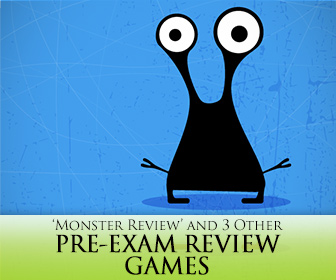
Every term, teachers watch their students’ stress levels rise as the shadow of looming exams reaches out and wraps them in its icy embrace.
But never fear, review games are here! At least that’s what I tell my kids when they look at me with the puppy-dog eyes and say, “teacher, this exam: easy?” Of course, the students are pretty unenthusiastic about writing practice exams, doing review worksheets, and other boring practice sessions. So here are 4 review games to mix a little fun into your review sessions.

Recycle and Review for the Exams without Extra Anxiety
-
1
Monster Review
This is possibly my favourite review game ever since it was introduced to me by a fellow NET in Korea. The best part is you need very few materials to make it work and it uses peer pressure to force all students to participate.
There are two approaches to this game, but for both of them you need to have a substantial list of questions. For a forty-five minute class I like to have at least thirty-five questions and I usually make forty-five to allow for some variety between classes. These are not just vocabulary questions, although some of those are good. Make sure you have fill-in-the blanks material, short answer questions, what is the difference between x and y, how do you say [write word on the board], etc. Cover as many different skills as you can.
Regardless of which method is used, the most creative monster at the end wins. You get some really weird creatures out of this game.For method one, you need a black/whiteboard, a variety of different colours of chalk or markers, and a die. Before you start, in a corner of the board write numbers one to six and assign each number a body part (ie. 1=head, 2=arm, 3=leg, 4=body, 5=eye, 6= accessory). Draw a line down the centre of the board. Divide the class into two teams and explain that each person can only answer one question. After they have answered one question they must help their teammates give the correct answer instead of answering themselves. Start asking questions. Whichever person raises their hand first and gets the question right comes to the front, rolls the die, and gets to add that body part to their team’s monster.
Method two is very similar to method one. The major difference is that the questions are categorized, often on a jeopardy-style PowerPoint, with each category assigned a body part. Whichever team answered the last question correctly then gets to choose the body part category for the next question. Whichever team gets that question can add that body part to their team’s monster.
Regardless of which method is used, the most creative monster at the end wins. You get some really weird creatures out of this game. As a warning, the students only start to really get into it after a few odd things have happened (ie. team one was forced to draw their third head in a row) then the laughter and chaos starts.
-
2
Knock-Back Review
Full disclaimer: you need to have really solid control of your class for this game to not deteriorate into bedlam. Create 3 different groups of questions/tasks. These should be of every variety and on any topic covered in the past term. I also like to throw in the odd ‘do five push-ups’ or ‘where is the teacher from’ card to keep them on their toes. Each group needs to be thirty-five to fifty cards. Create two sets of group one and two. Clear your classroom except for five desks in a line down the middle of the room. Place copies of Group 1 questions face down on desks one and five, Group 2 questions face down on desks two and four, and Group 3 questions face down on desk three (the middle desk). Divide the class into two teams. Line them up facing each other and perpendicular to the line of desks. One member of each team will start at opposite ends of the line of desks. They grab a card, read it aloud to their teammates, get the answer, repeat it, and then put the card down face up and move on to the next table. Students may not change questions, they must answer whatever they draw, and they must choose from the face down pile. When the students from each team meet in the middle they play rock, paper, scissors. The loser goes to the back of their line and the person next in their line starts at the first table. The winner continues towards the other team’s line. Whenever opponents meet they play rock, paper, scissors. If a team member manages to answer questions from all five tables that team gets a point.
This is a very noisy game, but the kids really enjoy it. However, it is essential that they remain in their lines and assist their teammates. If students are not paying attention it rapidly breaks down. If you have a co-teacher, it is helpful to have one teacher watch each team to maintain order and make sure there is no cheating.
-
3
Flyswatter Review
This game take a lot of up-front preparation time. The teacher must create a Powerpoint or other projected presentation that contains several pages with correct and incorrect answers scattered across the page. So first, create a set of review questions. Upwards of fifty is best. Then, in your presentation, write the answers randomly across the slide. Use text boxes for this, turn them randomly and make them various sizes. Each answer slide should be associated with approximately eight questions and have twelve to fifteen answers on it. Obviously, four to seven of these will be wrong.
To play, split the class into two teams. Project the answers onto a drop down screen at the front of class. Have each team send one member to the front and give those two students flyswatters (rolled up paper works as well). Read out, or write a question on the board. The first student to ‘swat’ the correct answer gets a point for their team. At some point the students will realize that if they just start swatting they will eventually hit the correct answer. At that point I institute a ‘three tries rule’ where they have only three attempts to get the correct answer. This tends to slow things down.
-
4
Jeopardy
Ever popular, jeopardy has been an ESL teacher’s staple for years, and with good reason. There seems to be no end to the adaptations of this game. Presentation templates are easily available on the internet, or, you can go old school and make category cards with the question on one side and point values on the other. Tape these up to the board under category headings (ie. vocabulary, grammar, excuses, conditional clauses, whatever applies). Divide the class into groups of four to six. Have team representatives play rock paper scissors to decide who gets to choose the first category and value. Read or show the question and the first team to raise their hand(s) or hit a bell (whichever the teacher prefers) gets a chance to answer first. Now, scoring can be at each teacher’s discretion. I choose not to subtract points for wrong answers because I want to encourage my students to talk as much as possible. That may not be a problem for other teachers. At the end, the team with the highest score is the winner.

Exams are stressful for students and teachers.
Helping the students have a bit of fun while still reviewing for their tests is a small mercy that we can give them. Endless worksheets and difficult writing and listening tasks are not necessarily bad, but they need to have some funs as well. And let’s face it: classes where there is laughter and excitement are way more fun for the teacher too!
P.S. If you enjoyed this article, please help spread it by clicking one of those sharing buttons below. And if you are interested in more, you should follow our Facebook page where we share more about creative, non-boring ways to teach English.







